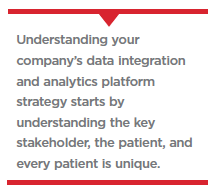 It’s really simple, data analytics drives decisions. In the healthcare industry, we use data to better understand the complexity of disease, improve forecasting and communications with patients, design more effective clinical trials, predict trends, customize treatment pathways, and so much more. My experience has proven that by breaking down traditional healthcare silos and integrating services, I can help clients manage data to improve efficiency and ultimately, patient outcomes. I like to start my exploration on helping clients improve efficiency by asking a simple question: What is your data integration and analytics platform strategy?
It’s really simple, data analytics drives decisions. In the healthcare industry, we use data to better understand the complexity of disease, improve forecasting and communications with patients, design more effective clinical trials, predict trends, customize treatment pathways, and so much more. My experience has proven that by breaking down traditional healthcare silos and integrating services, I can help clients manage data to improve efficiency and ultimately, patient outcomes. I like to start my exploration on helping clients improve efficiency by asking a simple question: What is your data integration and analytics platform strategy?
Delivering Value
Delivering value in the era of empowered patients renders the one-size-fit-all patient services program obsolete. In today’s digital world, patients are online seeking information and resources about their health and connecting with others who have the same conditions. Technology has enhanced patient engagement and adherence through the use of digital tools, like wearables, for example, that enable patients and providers to stay connected and allow for home-based care.
Over the years I have presented at numerous conferences on the transformational power of data science and artificial intelligence and how it helps companies make more informed decisions. I’m always incredulous when a company tells me it is using multiple vendors to provide data on key areas of focus — clinical trials, hub, patient  engagement, market access, and 3PL, for example. I wonder how they master the data to increase efficiency of patient services, overcome barriers to access and reimbursement, and improve healthcare effectiveness. Because I want to know how clients are using data, the second question I like to ask is: How are you creating a linked view of the patient journey to drive the success of your patient services?
engagement, market access, and 3PL, for example. I wonder how they master the data to increase efficiency of patient services, overcome barriers to access and reimbursement, and improve healthcare effectiveness. Because I want to know how clients are using data, the second question I like to ask is: How are you creating a linked view of the patient journey to drive the success of your patient services?
Patient services care models need to be built to answer this question. The best way to start is by putting the patient at the center of the solution because we know that we achieve greater value when the solution focuses on the needs of each patient. We also know that patients have different adherence issues; for example, I am more compliant when I’m prompted by my smart watch to take my allergy medication, yet my wife keeps track via the calendar on the fridge. So the solutions we build must establish metric-based patient segments along with data-driven approaches to patient profiles. Not every patient uses an app like I do, so patients need to be segmented by message response. Our solution must have the ability to track messages and segment performance, and be supported by a learning system to optimize engagement. In this environment, the patient services program we are building will significantly improve health outcomes through high-touch patient engagement and behavioral health technologies.
As my colleague, Bhaskar Sambasivan, President of Patient Services and Chief Strategy Officer at EVERSANA, shared in a recent article about the next generation of patient services, “It’s imperative that Patient Services 2.0 seamlessly yields a best-in-class experience brought forward by patient education and one-on-one interactions; timely communication and resolution of access, affordability, and adherence; and at-home product delivery and nursing care. This one ecosystem of integrated services not only keeps patients informed and empowered along their journey, but it generates positive outcomes to demonstrate real-world evidence of therapeutic success."
Understanding the Data Integration and Analytics Platform Strategy
Understanding your company’s data integration and analytics platform strategy starts by understanding the key stakeholder, the patient, and every patient is unique. Even patients within the same disease state have unique triggers that influence their behavior, and knowing this is important: Is she starting a new treatment journey? Was he recently discharged from the hospital? Is she caring for her children and her parents? Has he achieved his goals in healthcare? From interactions with physicians, the hospital and pharmacy, to advocacy groups, each touchpoint represents an opportunity for prediction and the opportunity to inform. An integrated strategy, focused on the patient, drives patient actions from clinical trial design and modeling to REMS program design, patient care journey mapping, real-world outcomes and efficacy, to market trends assessments. Your model design needs to capture every aspect of the patient journey in order to generate data that provides valuable insight that can be used for improvement.
Prediction enables actions to be taken and existing resources to be better utilized: the physician predicts outcomes, the hospital predicts readmission, the pharmacy predicts cost of care, and the advocacy group predicts adverse events. By identifying where the patient is in his treatment journey, we can predict probability of nonadherence, provide effective corrective actions, and measure the size of the potential impact.
This is why I want to know how my clients are using data. We can use this data to inform the “next best action" along the entire patient journey. Think about how the insight from this data can help you manage costs more effectively, improve adherence, optimize your launch performance, maximize pricing and reimbursement, and ensure that your market access strategies help you achieve full revenue potential.
Being able to predict the next best action increases your effectiveness in keeping patients on their medications. Data and analytics should be integrated within your patient services care model to improve your effectiveness in mobilizing your sales force, building distribution strategies, and achieving stakeholder intimacy.
The Next Generation of Patient Services Programs
As the industry continues its shift to a patient-centric, value-based model of care, it is critical that the next generation of patient services programs integrate data and analytics into their care models to track the programs’ success as well as to implement behavioral changes that produce better healthcare outcomes for their patients. Global data and analytics has the power to address critical challenges in healthcare and demonstrate the value of interventions. Combining research and AI-driven analytics can improve patient engagement and adherence. Understanding your data integration and analytics strategy will make all your stakeholders happy: engaging patients and providing more value to their treatment journey and by helping to reduce healthcare expenses. By mastering the data in an analytics platform, you are now prepared to drive the success of your patient services program.(PV)
EVERSANA is the leading independent provider of commercial services to the life sciences industry.
For more information, visit eversana.com.



















